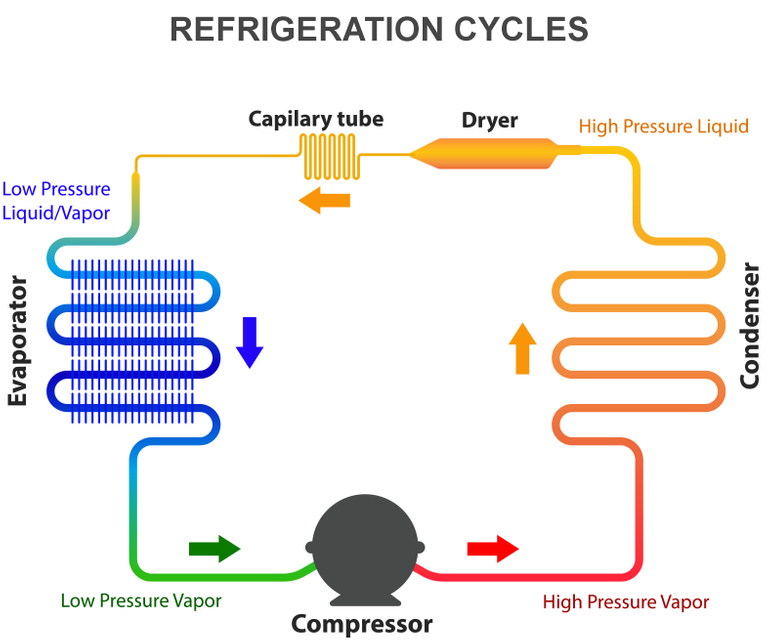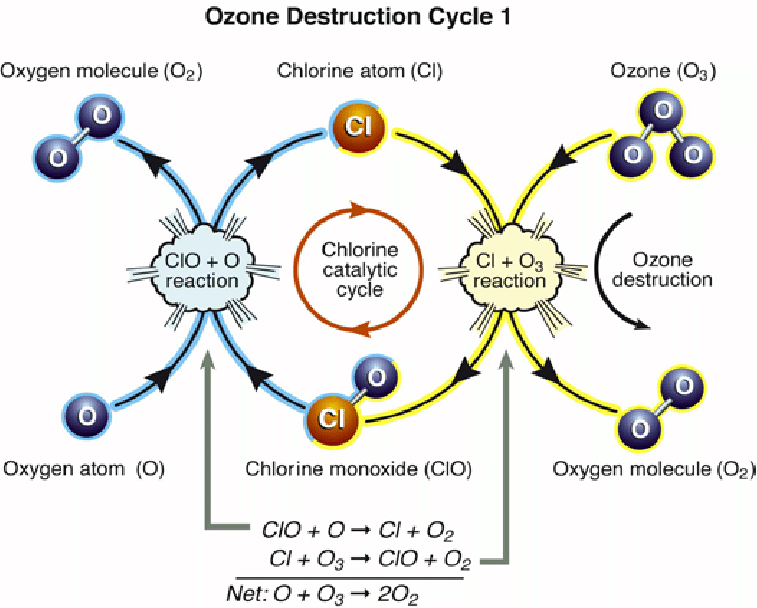To know the field of energetics starts here lesson #1. [FR/ENG]
Version française

Objectif 🎯
Cet article est préparé par @firasdidac et @energiesnow pour des connaissances générales sur les fluides frigorigènes :
🎯 Mettre le lecteur sur des bases solides pour la découverte du domaine énergétique.
🎯 Pour poser des questions à vous même qui vous aident à approfondir vos recherches.
🎯 Pour être à la page des actualités.
( je vous souhaite une bonne lecture). 🧓📚👴👵📕🧔👱♀️
Résumé: 📜
Dans ce résumé, nous verrons l'intérêt du fluide frigorigène dans notre quotidien et dans le monde, son impact sur l'environnement, les procédés et protocoles à suivre selon la réglementation, ses spécifications physiques et techniques, et ses dernières actualités.
Qu’est ce que c’est que le réfrigérant ?
Refrigerant est un mélange de substances chimiques. Ce mélange présente des caractéristiques très particulières dans des conditions spécifiques, telles que son état physique, sa température, sa pression, etc.
Qui a produit le premier réfrigérant ?
En 1929, l'ingénieur américain Thomas Jr. Midgley, et son équipe ont produit les premières molécules de dichloro-difluoro-méthane (CCl2F2) or R12.
Pourquoi le réfrigérant ?
L'intérêt des fluides frigorigènes réside dans leur transformation fréquente et leur pouvoir de fournir ou de dégager une quantité importante d'énergie thermique (chaleur) avec le changement de ses conditions.
Où peut-on trouver ce réfrigérant ?
Dans notre vie quotidienne, nous utilisons des fluides frigorigènes pour refroidir l'atmosphère, conserver nos aliments, produire de la glace...etc.
Toute installation qui transporte de la chaleur, pour la dégager ou l'apporter, ne peut fonctionner qu'avec un caloporteur. L'eau et l'air sont des caloporteurs. Mais le réfrigérant est un fluide caloporteur plus important si l'on compare sa chaleur spécifique (pouvoir calorifique) avec d'autres fluides. Ce matériau se trouve dans les machines frigorifiques telles que les réfrigérateurs, les congélateurs pour la conservation des aliments, les unités de condensation pour les chambres froides, les unités d'eau glacée pour le refroidissement par eau, le système split et rooftop pour le refroidissement par air et d'autres machines frigorifiques utilisées dans l'industrie. Le climatiseur de la voiture fonctionne au réfrigérant.
Comment les classer ?
Historiquement, selon le Protocol de Montreal pour éliminer progressivement les substances appauvrissant la couche ozone (O3), les fluides frigorigènes sont classés en trois familles, et une quatrième est fixée après, en fonction de leurs compositions chimiques. Avec une stratégie à long terme pour minimiser la pollution mondiale. Chaque fois représente progressivement une interdiction d'une famille selon l'importance de son impact sur l'environnement, jusqu'à atteindre l'objectif.
*Famille I [CFCs (Cloro-Fluoro-Carbure)]:
Chlorure (Cl), Fluor (F) et Carbon (C). En raison de la réaction du chlore sur la couche d'ozone (O3), c'est un fluide frigorigène interdit depuis 2004.
Exemples: R10 [Tétrachlorure de méthane (C Cl4)], R11[ Trichlo-fluoro-méthane (C Cl3 F), R12 [Dichloro-difluo-méthane (C Cl2 F2)] ...
- Famille II [HCFC (Hydro-Cloro-Fluoro-Carbure)]:
Hydrogène (H), Chlorure (Cl), Fluor (F) et le Carbon (C). Son impact sur la couche d'ozone (O3) est moins réactif que le CFC. C'est un fluide de transition de la famille I à la famille III.
Examples: Le célèbre R22 [Chloro-hydro-fluoro-méthane (CH Cl F2)], avec ses performances et sa large plage d'utilisation, il a été utilisé presque dans tous les domaines (Tertiaire, tertiaire pour chambres froides positives et négatives, industriel, transport, etc.).>>
- Famille III [HFC (Hydro-Fluoro-Carbure]:
Composé d'hydrogène (H), de fluor (F) et de carbone (C). Ce réfrigérant ne contient aucune particule de chlore (Cl). C'est un fluide qui n'a aucun effet sur la couche d'ozone (O3).
Exemples: R407C (mixture of R32 + R134a + R125), R410a (mixture of R32 + R125), R134a tetra-fluoro-ethane (C2H2F4)… etc.
Quelles sont les actualités des réfrigérants ?
La production de CFC et de HFC est totalement interdite depuis un certain temps. Un nouvel objectif de développement durable ODD concernant l'environnement, portée par la F-GAZ des normes pour minimiser les causes de l'effet de serre liées au potentiel de réchauffement du globe (PRG).
Noté bien : 📢 l’unité de mesure permettant d'évaluer le réchauffement potentiel d'un gaz à effet de serre est en fonction de sa durée de vie dans l'atmosphère et de sa capacité à absorber les rayons infrarouges
L'orientation sur le marché international est orientée vers l'utilisation de réfrigérants naturels comme l'ammoniac (R717), Le CO2(R744), le propane (R290) ...
Encore plus sur les réfrigérants: 📝💼
La stéréotypie des fluides frigorigènes est catégorisée selon son homogénéité (pure ou en mélange) et sa composition d'origine (naturelle ou artificielle). On retrouve ici les réfrigérants naturels, purs, azéotropiques et les réfrigérants azéotropiques.
***Je vous verrais au plus tôt, dans un deuxième article ***
Les sources des images:
Image 1 (modifié sur paint3D), image 2, image 3 (à gauche,à droite), image 4, image 5 (Réfrégérateur, climatiseur,groupe d’eau glacée , chambre froide,), image 6, image 7, image 8 (à gauche, à droite [au-dessus,au-dessous ]), image 9 (à gauche,
à droite), image 10 (left,right), image 11 (à gauche,à droite), image 12.
👩🎓👨🎓
Votre ami @firasdidac
English version

Objectif 🎯
This article is prepared by @firasdidac and @energiesnow for general knowledge about refrigerants:
🎯 Put yourself on a solid foundation for the discovery of the energy field.
🎯 To ask questions that help you to further your research.
🎯 Be on the news page
(I wish you a good reading).
Abstract: 📜
In this summary, we will see the interest of the refrigerant in our daily life and the world, its impact on the environment, the processes and protocols to be followed according to the regulations, its physical and technical specifications, and its last news.
What is the refrigerant?
Refrigerant is a mixture of chemical substances. This mixture has very special characteristics under specific conditions, such as its physical state, temperature, pressure, etc.
Who produced the first refrigerant?
In 1929, the American engineer Thomas Jr. Midgley, and his team produced the first molecules of dichloro-difluoro-methane (CCl2F2) or R12.
Why the refrigerant?
The interest in refrigerants lies in their frequent transformation and their power to provide or release a significant amount of thermal energy (heat) with the change of its conditions.
Where can we find this refrigerant?
In our daily life, we use refrigerants to cool the atmosphere, to preserve our food, to produce ice ... etc.
Any installation that transports heat, to release it or bring it, can only operate with a heat carrier. Water and air are heat carriers. But the refrigerant is a more important coolant if we compare its specific heat (calorific value) with other fluids. This material is found in refrigerating machines such as refrigerators, freezers for preserving food, condensing units for cold rooms, chilled water units for water cooling, the split and rooftop system for air cooling and other refrigeration machines used in industry. The car's air conditioner runs on refrigerant.
How can they be classified?
Historically, according to the Montreal Protocol to phase out ozone-depleting substances (O3), refrigerant is classified into three families, and a fourth is set after, according to their chemical compositions. With a long-term strategy to minimize global pollution. Each time gradually represents a ban of a family according to the importance of its impact on the environment, until reaching the goal.
*Family I [CFCs (Cloro-Fluoro-Carbide)]:
Chlorine (Cl), Fluorine (F) and Carbon (C). Due to the reaction of chlorine to the ozone layer (O3), it is a refrigerant banned since 2004.
Examples: R10 [Methane tetraclorure (C Cl4)], R11[Trichlo-fluoro-methane (C Cl3 F), R12 [Dichloro-difluo-romethane (C Cl2 F2)] ...
- Family II [HCFCs (Hydro-Cloro-Fluoro-Carbide)]:
Hydrogen (H), Chlorine (Cl), Fluorine (F) and Carbon (C). Its impact on the ozone layer (O3) is less reactive than the CFC. It is a transition fluid from family I to family III.
Examples: The famous R22 [Chloro-hydro-fluoro-methane (CH Cl F2)], with its performance and its wide range of use, it has been used almost in all areas (Tertiary, commercial for positive and negative cold rooms, industrial, transport, etc.).
- Family III [HFC (Hydro-Fluoro-Carbide]:
Composed of Hydrogen (H), Fluorine (F) and Carbon (C). This refrigerant does not contain any particles of Chlorine (Cl). It is a fluid that does not 'has any effect on the ozone (O3) layer.
Examples: R407C (mixture of R32 + R134a + R125), R410a (mixture of R32 + R125), R134a tetra-fluoro-ethane (C2H2F4)… etc.
What is the news about refrigerants?
The production of CFCs and HFCs have been totally banned for some time. A new sustainable development goal currently SDG concerning the environment, driven by the F-GAZ standards to minimize the causes of the greenhouse effect which relates to the global warming potential (GWP).
Noted well: 📢 The unit of measurement used to assess the potential warming of a greenhouse gas according to its lifespan in the atmosphere and its capacity to absorb infrared rays.
The orientation in the international market is directed towards the use of natural refrigerants like ammonia (R717), CO2(R744), propane (R290) ...
I want to know more about refrigerants: 📝💼
The stereotypy of refrigerants is categorized according to its homogeneity (pure or mixture) and its original composition (natural or artificial). Here we find natural refrigerants, purs refrigerants, azeotropic refrigerants and azeotropic refrigerants.
I see you soon, in the next lesson
Sources of images:
Image 1 (modified with paint3D), image 2, image 3 (left,right), image 4, image 5 (Fridge, Air conditioner unit,chiller,cold room,), image 6, image 7, image 8 (left,right [above,below ]), image 9 (left,right), image 10 (left,right), image 11 (left,right), image 12.
Do not hesitate to comment on post.
Your friend @firasdidac
👇👇👇











Merci M @firasdidac pour cet effort et pour la traduction de l'article. 💯🙏🙏👌👏
👍
Thank you my prof. ❤️❤️🌹
You are welcome adem
Merci M. Firas d'ajouter les sources sur l'article.
You are welcome youssef
Merci Monsieur pour cette qualité de présentation.
You are welcome haroun
Merci M.Firas pour cet aide mémoire, j'apprécie votre effort à consolider nos connaissances.✒️📝
Merci pour ton commentaire @tasnimova .
C'est un article claire et signifiant. merci.❄️☃️
Merci d'avoir préparé cet article en français et en anglais.
La qualité de présentation est remarquable. Je vous remercie de nous publier cet article en français.
c'est article riche qui nous aide à avancer. J'attend votre deuxième leçon.
Congratulations @firasdidac! You have completed the following achievement on the Hive blockchain and have been rewarded with new badge(s):
Your next target is to reach 200 upvotes.
You can view your badges on your board and compare yourself to others in the Ranking
If you no longer want to receive notifications, reply to this comment with the word
STOPCheck out the last post from @hivebuzz:
Thank you @hivebuzz for this information you provided to me, I very much appreciate your effort. ♥️🌹🎇🧨✨🎈
De nada @firasdidac, buen trabajo! 😊👍
Congratulations @firasdidac! You received a personal badge!
Thank you for helping the Papillon Foundation by participating in the Weekly Hive Charity Giveaway.
Your support to "create better tomorrows from the ashes of today" is much appreciated!
You can view your badges on your board and compare yourself to others in the Ranking
Check out the last post from @hivebuzz:
Hello.
Welcome to Hive.
To confirm your authorship of the content, could you please mention the word "Hive" in your Facebook profile:
https://www.facebook.com/firas.bab/about_contact_and_basic_info
You can remove this mention, once we confirm the authorship.
Thank you.
More Info: Introducing Identity/Content Verification Reporting & Lookup